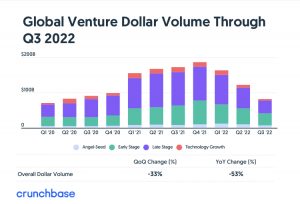Global VC funding in Q3 2022 was $81B, down 53% YoY from $171B and 33% QoQ from $121B,
the lowest level since $70.6B in Q1 2020
(@geneteare/ Crunchbase News)

.
Global VC Pullback Is Dramatic In Q3 2022
.
—–

Bloggin internal news

.
.
—–
.
.
.
.
—–
In 2014, mobile security startup Good Technology was valued at $1.1 billion. Employees thought their equity packages were winning lottery tickets. They were wrong.
One year later, Good sold for $425 million. Employee share prices tumbled from $4.32 a share to $0.44. While executives made millions, employees—some of whom paid $100,000+ in taxes on their equity—made next to nothing.
Good Technology’s situation isn’t uncommon. Like so many startups, it had investors and board members whose equity was protected by high liquidation preference—a guarantee that they get paid first and at least a certain amount when the company sells. When startup investors make millions in a sale, but money runs dry before reaching employees, a bad preference stack is often the cause.
To avoid being surprised when the company you work for is acquired, you need to understand what preferences are, why they’re important, and how you can negotiate around them.
If your equity package works out to 0.1% of the company, shouldn’t you be entitled to 0.1% of the acquisition? Startup financing isn’t that simple.
When a startup is sold, the money it makes is paid to shareholders in a predetermined order, called its “preference stack.” As a rule, employees are last, while shareholders with liquidation preference (LP) come first.
Three factors affect liquidation preference, and understanding them can give you a better sense of who gets paid how much and when: